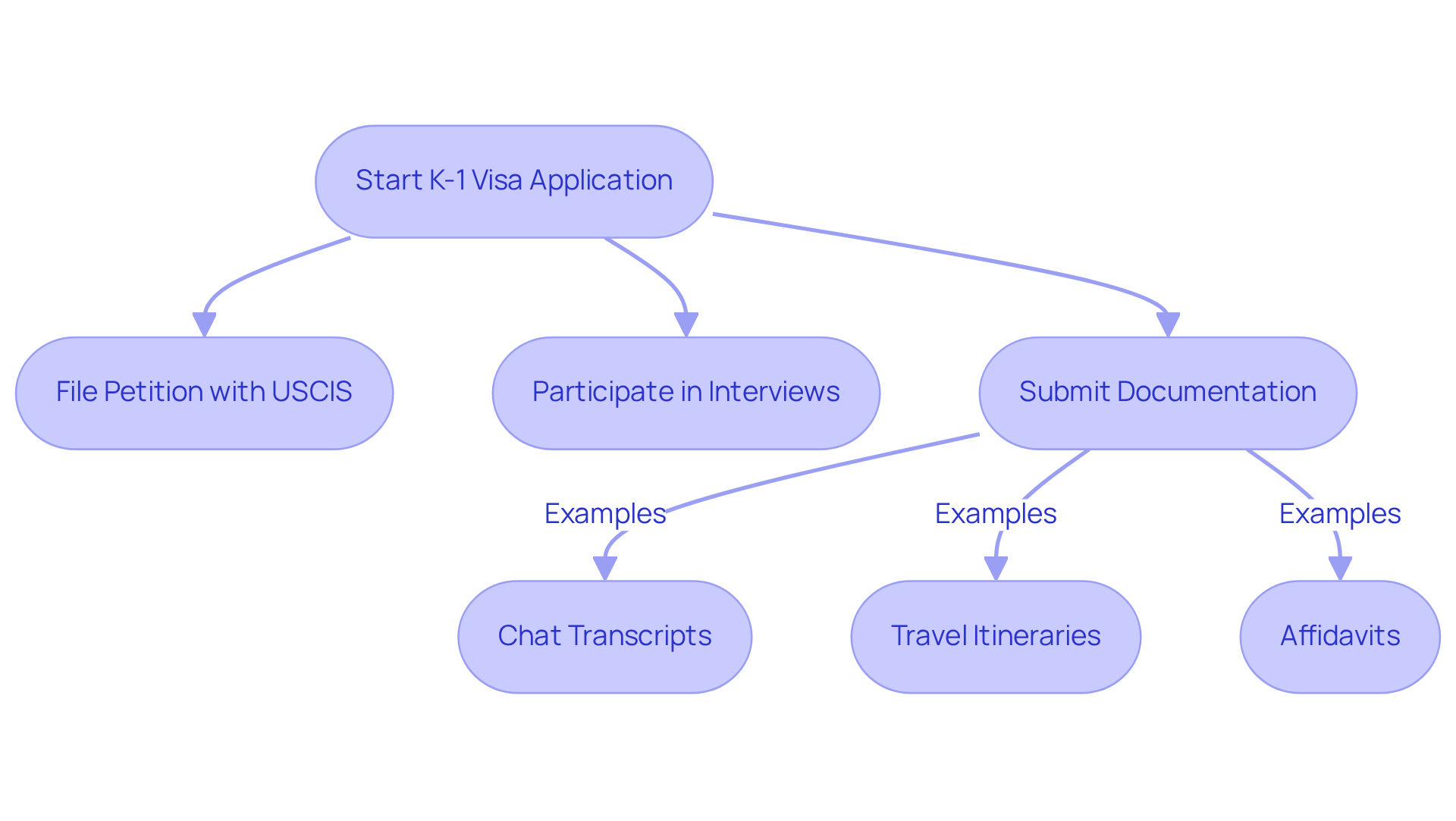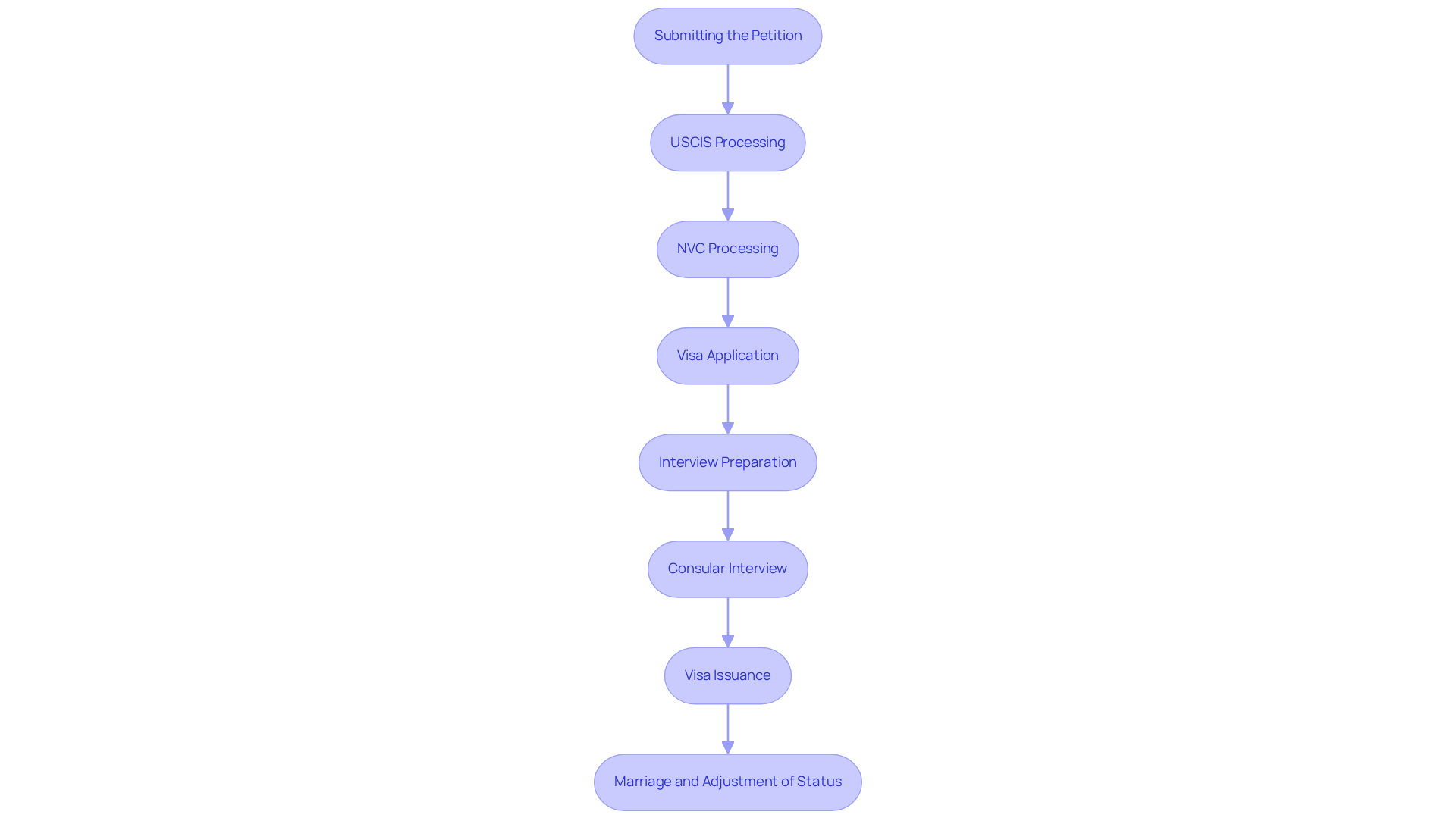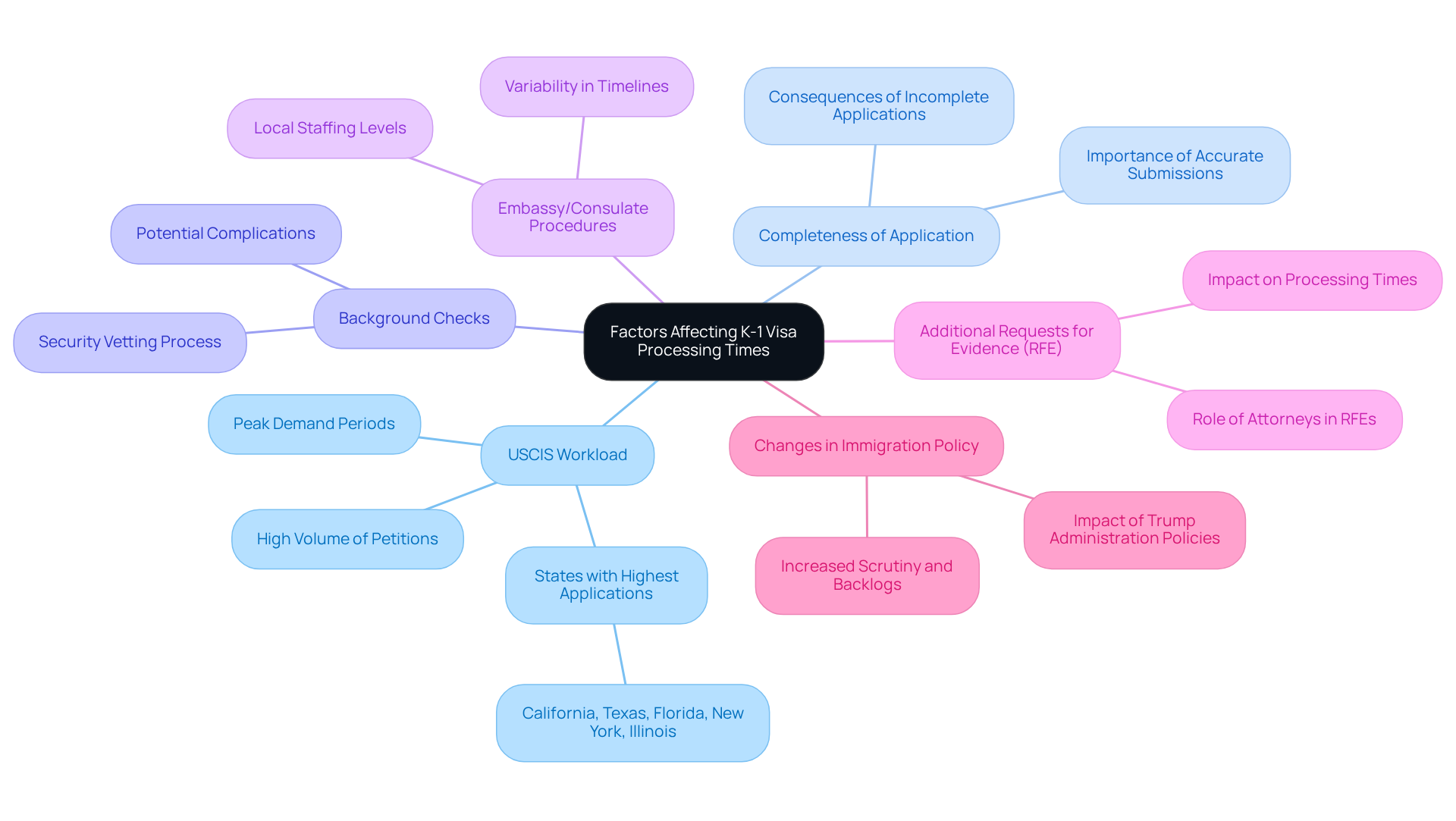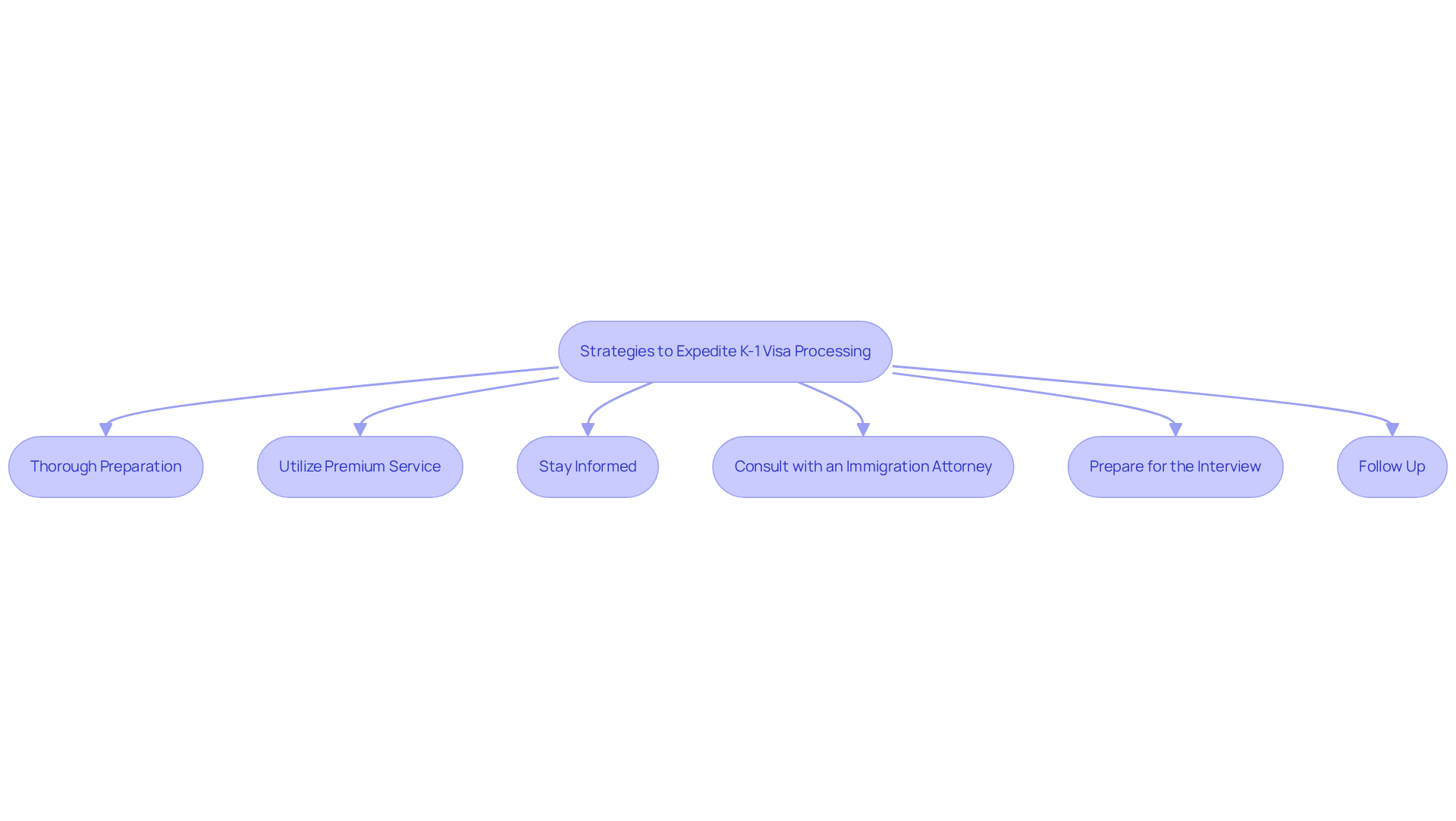Overview
Navigating the K-1 visa process can be challenging, and it's important to understand that several factors influence the processing time. These include:
- The completeness of your application
- The current workload of USCIS
- Any recent changes in immigration policy
Currently, the average processing time is around six months.
You may be feeling overwhelmed, but thorough preparation can make a significant difference. Utilizing premium services and consulting with immigration attorneys can help expedite the process. Remember, proper documentation and proactive communication with USCIS and consulates are essential.
It's crucial to take these steps seriously, as they can lead to a smoother experience. Consider reaching out for professional guidance to ensure you're on the right path. You're not alone in this journey, and support is available to help you navigate the complexities of the K-1 visa application.
Introduction
Navigating the complexities of the K-1 visa process can feel overwhelming for couples eager to unite in the United States. This essential non-immigrant visa not only facilitates the entry of a foreign fiancé(e) but also sets the stage for marriage within a tight 90-day window. As processing times lengthen due to increased scrutiny and evolving immigration policies, it's important to recognize that understanding the steps and strategies for success has never been more critical.
How can you ensure your journey is as smooth and efficient as possible amidst these challenges? Remember, you’re not alone in this process.
Define the K-1 Visa and Its Purpose
The K-1 permit, often referred to as the fiancé(e) permit, is a vital non-immigrant authorization that allows the foreign fiancé(e) of a U.S. citizen to enter the United States with the intention of marriage. It’s essential for couples to wed within 90 days of the foreign fiancé(e)'s arrival in the U.S., making this permit a crucial step for engaged partners from different nations eager to start their life together. While the K-1 permit itself does not grant permanent residency, it opens the door to obtaining a green card after marriage through further applications.
Navigating the K-1 application process can feel overwhelming, as it involves several key steps:
- Filing a petition with the U.S. Citizenship and Immigration Services (USCIS)
- Participating in interviews
- Submitting comprehensive documentation to demonstrate the authenticity of the relationship
For instance, applicants are encouraged to provide evidence such as chat transcripts, travel itineraries, and affidavits from family and friends to validate their connection. In 2024, the U.S. Department of State issued approximately 35,925 K-1 permits, indicating a significant increase in activity.
It’s important to remember that recent updates to the K-1 application have introduced more rigorous scrutiny, leading to longer K-1 visa processing times. Applicants are advised to prepare thoroughly and seek guidance from experienced immigration attorneys to navigate these complexities effectively. As specialists in the field emphasize, understanding the K-1 application's requirements and maintaining transparent communication during submission is crucial for success.
If you find yourself facing legal emergencies—such as ICE enforcement actions, deportation proceedings, or other urgent situations—knowing your rights and taking immediate action is essential. We invite you to reach out to us at Vasquez Law Firm for confidential legal consultations, ensuring you are well-prepared for any challenges that may arise. We are dedicated to providing accessible legal representation, ensuring that financial constraints do not impede your pursuit of justice. We operate on a contingency fee basis for personal injury cases, meaning you pay nothing unless we win. For immigration matters, we offer flexible payment plans tailored to your financial situation. Remember, your rights and freedom may depend on taking action now.

Outline the K-1 Visa Application Process
The K-1 visa application process involves several critical steps that ensure a smooth transition for couples planning to marry in the U.S. You may be feeling overwhelmed by the complexities, but understanding each step can ease your journey:
- Submitting the Petition: The U.S. citizen begins by submitting Form I-129F, Petition for Alien Fiancé(e), with U.S. Citizenship and Immigration Services (USCIS). This form is crucial as it establishes the legitimacy of your relationship and initiates the application process.
- USCIS Processing: After submission, USCIS reviews the petition. If approved, your case is forwarded to the National Visa Center (NVC) for further processing.
- NVC Processing: The NVC assigns a case number and sends the petition to the appropriate U.S. embassy or consulate, marking a significant step in your journey.
- Visa Application: The foreign fiancé(e) must complete Form DS-160, the Online Nonimmigrant Application, and pay the associated application fee.
- Interview Preparation: Gathering essential documents is vital. This includes proof of your relationship, such as chat transcripts, flight itineraries, photographs, and affidavits, along with financial support and identity verification. Being well-prepared is crucial for a successful interview.
- Consular Interview: The foreign fiancé(e) attends an interview at the U.S. embassy or consulate, where they must convincingly demonstrate the authenticity of their relationship.
- Visa Issuance: If the interview is successful, the K-1 visa is issued, allowing the fiancé(e) to travel to the U.S. for marriage.
- Marriage and Adjustment of Status: After marrying within 90 days of arrival, the couple can apply for the foreign spouse's adjustment of status to obtain a green card, completing the transition to permanent residency.
Navigating this intricate procedure can be daunting, but you don’t have to do it alone. At Vasquez Law Firm, we offer a complimentary consultation to discuss your case details and provide tailored legal guidance. Here’s how to engage with our services:
- Schedule Your Free Consultation: Reach out to us to set up a meeting.
- Meet with Our Attorneys: Discuss your specific situation with our experienced legal team.
- Receive Customized Legal Guidance: Obtain tailored assistance regarding your K-1 application.
- Learn About Your Options: Understand the best strategies for your case.
Recent changes in K-1 visa application steps have introduced additional scrutiny, making it essential for applicants to provide thorough documentation and evidence of their relationship. Immigration attorneys emphasize the importance of being well-prepared for each stage to enhance your likelihood of approval. While the K-1 visa processing time averages around six months, it's important to note that this timeframe can vary, and recent policy changes have led to longer administrative wait times. Engaging an immigration attorney can provide valuable assistance in navigating these complexities.

Identify Factors Affecting K-1 Visa Processing Times
Navigating the K-1 visa application process can be challenging, and several factors significantly influence the processing times:
- USCIS Workload: It's important to remember that the volume of petitions received by USCIS can lead to considerable delays. In 2024, California, Texas, Florida, New York, and Illinois represented 34% of all K-1 visa applicants, which can burden capacity during peak demand periods.
- Completeness of Application: You may be feeling overwhelmed, but submitting complete and accurate applications is crucial. Incomplete or incorrect submissions can result in significant delays, so ensuring that all required documents are accurately submitted is essential to avoid setbacks.
- Background Checks: Security and background checks on the foreign fiancé(e) can prolong the process, especially if complications arise during the vetting. This can be a stressful time, but understanding this step can help you prepare.
- Embassy/Consulate Procedures: Each U.S. embassy or consulate operates under its own timelines, which can differ based on local circumstances, staffing levels, and operational effectiveness. It's vital to stay informed about these variations.
- Additional Requests for Evidence (RFE): If USCIS or the consulate needs more information, this can significantly prolong timelines. Attorneys play a vital role in assisting applicants in responding to RFEs effectively, ensuring that the necessary additional documentation is provided to keep the application on track.
- Changes in Immigration Policy: Shifts in immigration laws or policies can also affect processing times. For instance, the Trump administration's policies introduced more stringent vetting procedures, which historically led to significant backlogs and longer wait times. Remaining knowledgeable about existing regulations and possible modifications is crucial for applicants to navigate the procedure successfully.
As of March 2025, the K-1 visa processing time for handling a K-1 application is roughly 6 months, indicating enhancements from earlier years. Understanding these elements can empower you to better prepare for the K-1 application process and seek the support you need along the way.

Explore Strategies to Expedite K-1 Visa Processing
To expedite the k1 visa processing time, applicants can implement several effective strategies that not only simplify the process but also alleviate some of the stress involved.
-
Thorough Preparation: It's crucial to complete all forms accurately and gather the necessary documents before submission. This proactive step can help prevent delays that might add to your anxiety.
-
Utilize Premium Service: If available, consider choosing premium service for the I-129F petition. This option can significantly reduce wait times, potentially saving you several months. For example, the K-1 visa processing time improved from a peak of 13.9 months in 2023 to just 6.1 months in early FY2025, thanks to USCIS enhancements like digital filing and automation.
-
Stay Informed: Regularly checking your application status on the USCIS website can help you feel more in control. Responding quickly to any requests for extra information keeps the process moving smoothly, which is so important during this time.
-
Consult with an Immigration Attorney: Engaging a knowledgeable immigration lawyer can provide essential insights and guidance. This support ensures adherence to USCIS standards and can help accelerate your application procedure. As noted by a VisaNation Law Group attorney, "An experienced K-1 immigration lawyer will clarify the procedure and how to speed up the K-1 timeline if feasible."
-
Prepare for the Interview: Preparing thoroughly for the consular interview can ease your nerves. Practicing potential questions and organizing all required documentation for easy access will help you feel more confident.
-
Follow Up: In case of unexpected delays, it's important to proactively follow up with USCIS or the consulate. Inquiring about your status and resolving any issues quickly can make a significant difference. Remember, the NVC processing is just a smaller part of the overall K-1 visa application process compared to USCIS processing, so staying engaged is key.

Conclusion
Navigating the K-1 visa application process can feel overwhelming for couples eager to unite in the United States. This non-immigrant visa not only allows a foreign fiancé(e) to enter the country but also sets the stage for marriage and the subsequent journey toward obtaining a green card. It's important to remember that understanding the complexities of the application process—from petition submission to the final interview—is crucial for ensuring a smooth path toward marriage.
You may be feeling anxious about the various stages involved in obtaining a K-1 visa. Key insights highlight the importance of thorough documentation and the potential impact of external factors such as USCIS workload and changes in immigration policy. By exploring strategies to expedite processing, like utilizing premium services or engaging with an immigration attorney, you can navigate this process with confidence and efficiency.
Ultimately, the K-1 visa represents more than just a permit; it symbolizes the love and commitment shared between couples separated by borders. By taking proactive steps and seeking the right support, you can streamline your journey and reinforce the significance of your relationship. Embracing this process with preparation and determination can lead to a successful outcome, allowing you and your partner to embark on a beautiful new life together in the United States.
Frequently Asked Questions
What is the K-1 Visa?
The K-1 Visa, also known as the fiancé(e) permit, is a non-immigrant authorization that allows the foreign fiancé(e) of a U.S. citizen to enter the United States with the intention of marriage.
What is the purpose of the K-1 Visa?
The purpose of the K-1 Visa is to enable couples from different countries to marry in the U.S. Couples must wed within 90 days of the foreign fiancé(e)'s arrival.
Does the K-1 Visa grant permanent residency?
No, the K-1 Visa does not grant permanent residency. However, it allows for the possibility of obtaining a green card after marriage through further applications.
What are the key steps in the K-1 application process?
The key steps in the K-1 application process include filing a petition with the U.S. Citizenship and Immigration Services (USCIS), participating in interviews, and submitting comprehensive documentation to demonstrate the authenticity of the relationship.
What kind of documentation is recommended for the K-1 application?
Recommended documentation includes evidence such as chat transcripts, travel itineraries, and affidavits from family and friends to validate the relationship.
How many K-1 permits were issued in 2024?
In 2024, approximately 35,925 K-1 permits were issued by the U.S. Department of State, indicating a significant increase in activity.
What recent changes have affected the K-1 application process?
Recent updates have introduced more rigorous scrutiny of K-1 applications, leading to longer processing times.
What advice is given to applicants regarding the K-1 application?
Applicants are advised to prepare thoroughly, seek guidance from experienced immigration attorneys, and maintain transparent communication during the submission process.
What should individuals do if they face legal emergencies related to immigration?
Individuals facing legal emergencies, such as ICE enforcement actions or deportation proceedings, should know their rights and take immediate action. They can reach out for confidential legal consultations.
What kind of payment options are available for legal representation?
The Vasquez Law Firm offers flexible payment plans tailored to individual financial situations and operates on a contingency fee basis for personal injury cases, meaning clients pay nothing unless they win.




